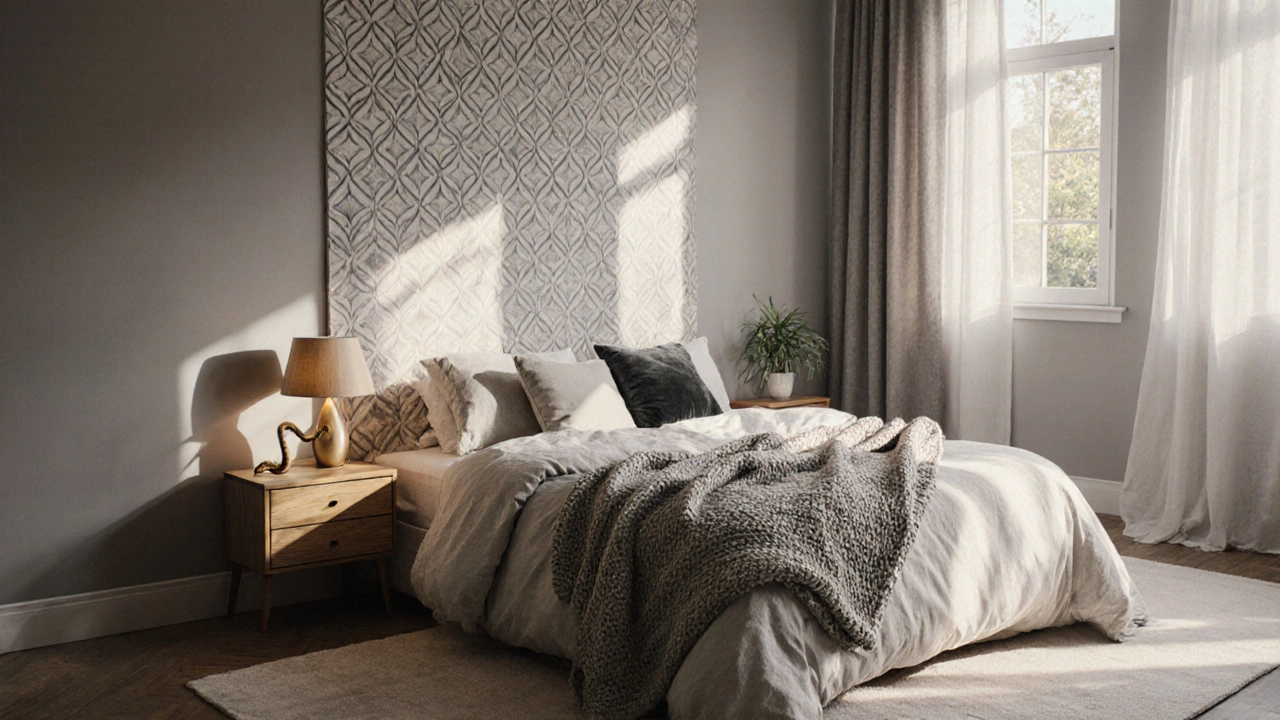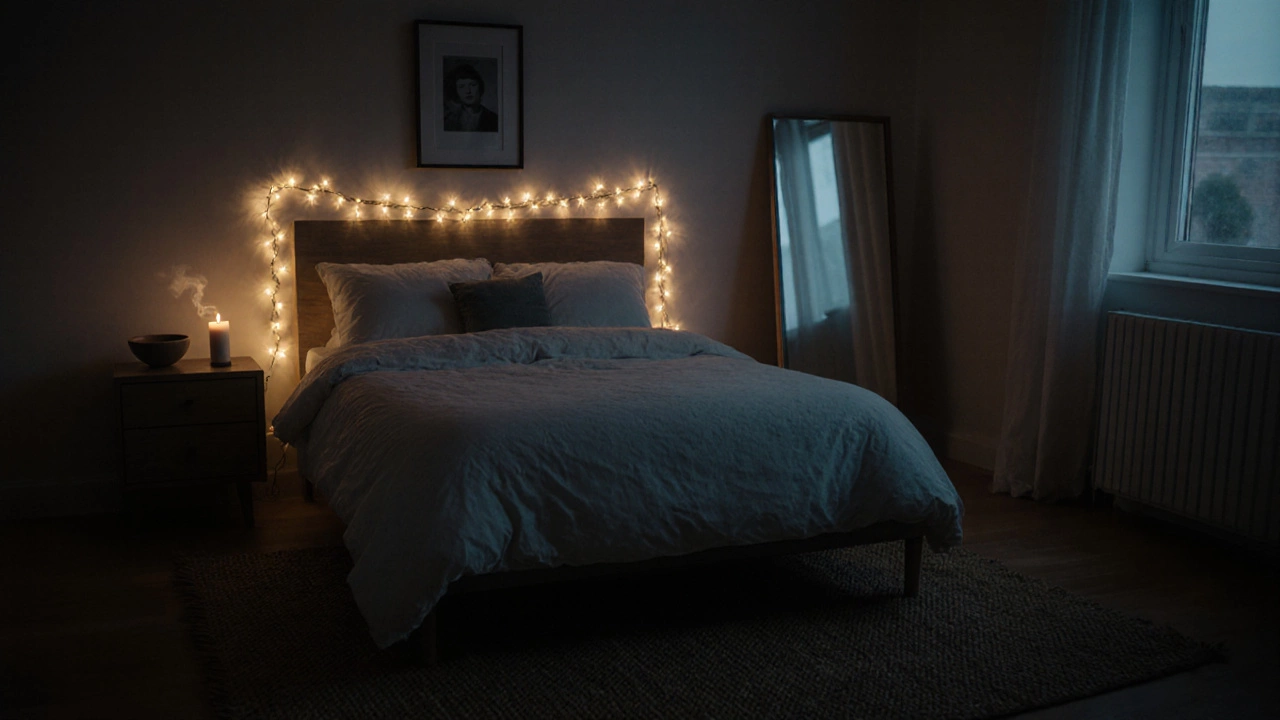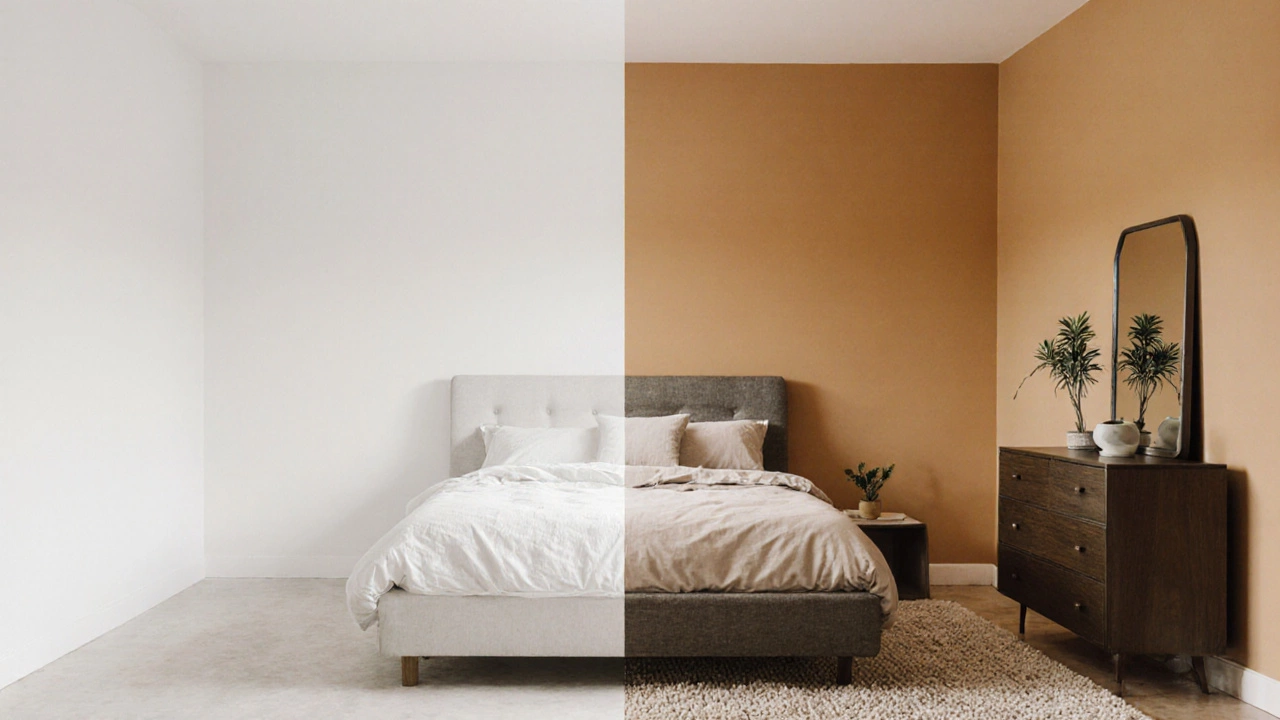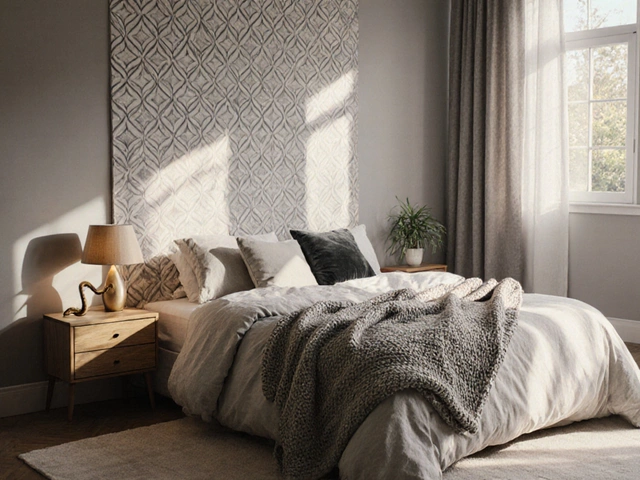How to Make Your Plain Bedroom Look Nice Without Spending Much

Bedroom Decor Budget Calculator
Accent Walls
Bedding Layers
Lighting
Plants & Decor
Rugs & Flooring
You walk into your bedroom and it feels... empty. Not cozy. Not calm. Just blank. Walls, a bed, maybe a dresser. No personality. No warmth. That’s not a bad room-it’s just unfinished. And the good news? You don’t need a big budget or a designer to turn it into a space you actually love. Making a plain bedroom look nice is about small, smart choices that add feeling, not just stuff.
Start with the walls
White walls aren’t bad-they’re a canvas. But if they’re the only thing you’ve got, they’ll feel cold. A single coat of paint can change everything. Go for something soft: warm gray, creamy beige, or even a muted sage. These colors don’t scream, but they breathe. They make the room feel bigger and calmer. Avoid pure white unless you’ve got tons of natural light and layered textures to balance it. In Auckland, where winters are damp and light is soft, warm neutrals work better than stark tones.
Still not ready to paint? Try removable wallpaper. There are now tons of peel-and-stick options with subtle patterns-geometric lines, organic textures, even faux brick. Stick one behind your bed as an accent wall. It’s instant character, zero mess, and easy to remove if you move.
Layer your bedding
Your bed is the center of the room. If it looks flat, the whole space feels flat. Start with a crisp white or light gray fitted sheet. Then add a flat sheet in a slightly different tone-maybe oatmeal or soft taupe. On top, throw a lightweight quilt or duvet in a natural fiber like linen or cotton. Don’t go for super shiny or synthetic fabrics-they look cheap under soft light.
Now, add texture. Drape a chunky knit throw at the foot of the bed. Fold two or three pillows in front: one firm, one medium, one soft. Mix sizes. A standard pillow, a lumbar pillow, maybe a small square one. Use different fabrics-cotton, velvet, linen. Don’t match everything. A little mismatch feels intentional, not staged.
Lighting changes everything
Overhead lights are functional, not friendly. They turn your bedroom into an operating room. Add at least one soft light source that’s not the ceiling. A bedside lamp with a fabric shade is the easiest fix. Look for one with a warm bulb-2700K or lower. That’s the golden hour glow, not the harsh blue of a phone screen.
If you can’t fit a lamp on your nightstand, try wall sconces. They save space and cast light upward, which bounces gently off the ceiling. Or hang a small string of fairy lights behind the headboard. Not the cheesy kind-the thin, LED ones that look like stars. They turn nighttime into a quiet retreat.
Bring in nature
Plants are the quickest way to add life to a plain room. You don’t need a jungle. One or two low-maintenance plants do the trick. A snake plant in a ceramic pot, a ZZ plant on the dresser, or a trailing pothos hanging from a shelf. They clean the air, soften hard edges, and make the space feel cared for.
If you don’t trust your green thumb, go for dried flowers or a simple branch in a vase. A eucalyptus stem or a few wheat stalks in a tall glass jar add movement and texture without needing water. They last months and don’t cost much.

Use rugs to define space
A bare floor makes a room feel hollow. Even a small rug under the bed makes a difference. Look for one that’s at least two-thirds the width of your bed. A jute or wool rug in a neutral tone adds warmth underfoot and ties the bed area together. Avoid thin, plastic-looking rugs-they flip up, catch on shoes, and look temporary.
If you’re on a tight budget, check secondhand stores or Facebook Marketplace. A good rug from a thrift shop can be cleaned and repurposed for under $30. It’ll outlast a cheap new one.
Declutter and curate
A plain room becomes a boring room when it’s full of random stuff. Clear off your nightstand. Keep only what you use daily: a lamp, a book, maybe a small candle. Put everything else away. Use under-bed storage bins for seasonal clothes. Tuck extra blankets in a basket at the foot of the bed.
Then, add one or two meaningful objects. A framed photo of a place you love. A small ceramic bowl you picked up on a trip. A single piece of art-no need for a gallery wall. One thoughtful item says more than five random ones.
Think about flow
How do you move through the room? If your dresser blocks the path to the window, it feels cramped. Rearrange. Move the bed so there’s space on both sides. Pull the dresser away from the wall if you can. Even a few inches of breathing room makes the room feel larger.
Use mirrors to bounce light. A simple leaner mirror on the wall opposite a window doubles the daylight. It tricks the eye into thinking the space is bigger. No need for a fancy frame-just a clean, rectangular one in wood or black metal.

Finish with scent and sound
Smell is memory. Light a soy candle with a quiet scent-lavender, sandalwood, or unscented if you’re sensitive. Avoid overpowering florals or synthetic fragrances. The goal is to feel calm, not like you’re in a perfume shop.
Sound matters too. A small Bluetooth speaker on the dresser lets you play soft music or rain sounds at night. No need for fancy systems. Even a $20 speaker from a local store will do. Just keep it out of sight when not in use.
What not to do
Don’t buy matching sets. A bed frame, nightstands, and dresser all in the same wood tone look like a catalog photo-not a home. Mix materials: wood, metal, rattan, ceramic. It feels lived-in.
Don’t hang curtains too high or too short. Hang them close to the ceiling and let them pool slightly on the floor. It makes windows look taller and the room feel grander.
Don’t ignore the ceiling. A plain white ceiling is fine, but if it’s stained or dusty, it pulls the whole room down. Give it a quick clean or repaint it the same color as your walls. It creates a seamless, calm look.
Final checklist: Your 7-day bedroom upgrade
- Day 1: Paint one accent wall or apply removable wallpaper behind the bed.
- Day 2: Layer your bedding with a quilt, two pillows, and a throw.
- Day 3: Add one bedside lamp with a warm bulb.
- Day 4: Place one plant or dried arrangement on a shelf or dresser.
- Day 5: Lay down a rug under the bed, even if it’s small.
- Day 6: Clear your nightstand. Keep only lamp, book, and one personal item.
- Day 7: Hang a mirror to reflect light and open up the space.
You don’t need to do it all at once. Start with one thing. Maybe just the lamp. Then the rug. Then the plant. Slow changes stick better than big overhauls. And before you know it, your plain bedroom won’t feel plain anymore-it’ll feel like yours.
Can I make my plain bedroom look nice without buying anything?
Yes. Rearranging furniture, decluttering, cleaning windows, hanging a mirror, and reorganizing your bedding can completely change the feel of the room. Sometimes, just flipping your pillows or moving your nightstand a foot to the left makes a surprising difference. Your existing items, arranged with intention, can feel brand new.
What color should I paint my plain bedroom?
Go for warm neutrals: soft greys, creamy whites, light taupes, or muted greens. These colors reflect natural light gently and feel calming, especially in places like Auckland with overcast winters. Avoid cool whites or bright whites-they can make the room feel sterile. Test paint samples on different walls at different times of day before committing.
How many pillows should I put on my bed?
Two to four is ideal. Use one or two large pillows for support against the headboard, then add one or two smaller decorative pillows in front. Mix shapes and textures-like a square pillow next to a long lumbar one. Too many look messy; too few look bare. The sweet spot is just enough to feel cozy, not cluttered.
Is a rug really necessary in a bedroom?
It’s not mandatory, but it’s one of the easiest ways to add warmth and anchor the bed. A rug under the bottom two-thirds of your bed creates a sense of groundedness. Even a small 5x8 rug makes a difference. Skip thin, plastic rugs-they slip and look cheap. Go for wool, jute, or cotton blends that feel soft underfoot.
What’s the cheapest way to add personality to my bedroom?
One framed photo, postcard, or piece of art. Hang it at eye level, centered above your bed or dresser. It doesn’t have to be expensive-print your own favorite image, use a thrifted frame, or even tape a beautiful magazine cutout to cardboard. Personal meaning matters more than price. That one object tells the room you live there, not just sleep there.
Should I get new bedding or just update what I have?
You don’t need new sheets. Wash what you have in hot water to brighten them. Then layer a simple throw blanket over the bed and add a couple of new pillows. A $15 pillow cover in a textured fabric can make your existing bedding look luxurious. Focus on texture and layering, not brand-new sets.
Next steps if you’re ready to go further
If you’ve done the basics and still want more, try adding a small shelf above your dresser for books or a tiny plant. Swap out plain drawer pulls for brass or ceramic ones-they’re cheap and make a big difference. Or hang a tapestry or woven wall hanging for softness and color.
Remember: a nice bedroom isn’t about perfection. It’s about comfort. It’s about waking up somewhere that feels like a quiet hug. You don’t need a magazine spread. You just need a few thoughtful touches that say, ‘This is mine.’
